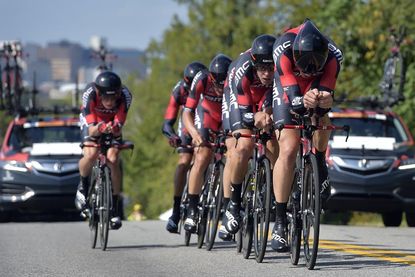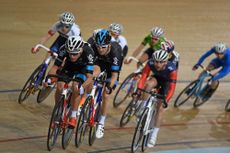Velon launches new team-based pro cycling race series
New Hammer Series aims to provide intense racing spectacle in cities across the globe

The BMC Team in action during the 2015 UCI World Championships TTT
Velon, the company created by top pro teams including Sky, has launched a new race series focusing on team competition.
The Hammer series, which has been developed in partnership with marketing company Infront, will see teams of seven compete over the course of three days in a new competition format designed to emphasize team competition.
The series will start with just one event this season, the Hammer Limberg on June 2-4, and will feature 12 WorldTour teams - including the ten Velon teams, Movistar and Bahrain-Merida – and four Pro Continental teams.
Velon chief executive Graham Bartlett said that he planned to have between three and four Hammer events next year, rising to between eight and 10 in following years.
>>> Velon interview: Can it give fans what they want with promises of on-screen data?
Bartlett said: “We’re trying to create a connected story and you can do that by joining up what’s there but it’s difficult because one, the rights are very fragmented, from an economic point of view. And two, the races are very different the tactics of a one-day race are very different to a stage race. So how does a stage race relate to a one-day race. We are trying to create a consistent format.”
The races will be classed as UCI hors categorie (HC) races, one step down from WorldTour level.
Get The Leadout Newsletter
The latest race content, interviews, features, reviews and expert buying guides, direct to your inbox!
Bartlett said that television coverage of the Limberg race was still being worked out but that there was “great interest” from broadcasters.

He added that basing the race in a single location would allow the race’s organisers to put on other entertainment such as bands and music throughout the weekend creating a “festival atmosphere”. He also said that there may be scope to include women’s races in future but that it was important to prove the format was exciting and attractive to spectators first.
When asked about competing with historic and established races, Bartlett said: “We want to complement that… We think there’s room for a different type of event. Will it go on with other races, yes, but the Tour de Suisse already overlaps with the Critérium du Dauphiné, the Tour of California already overlaps with the Giro d’Italia, it's unavoidable.”
Chris Froome (Team Sky) said: “Whenever I win I always say the same thing - it wouldn’t be possible without the team. We go to the biggest races with what we think is the strongest team, and what’s great about the Hammer Series is it will really put that to the test. It’s something new and a chance for fans to see teams competing directly against each other.”
>>> What is Velon, and what will it do?
Velon was set up by ten WorldTour teams to help come up with additional ways of making money in an effort to make teams more financially sustainable.
To date it has been most well known for its cameras on bikes in races and other data that it provides from the riders.
When asked how far the new series would contribute to sustainability for team, Bartlett said: “Given the sustainability right now is virtually zero anything you advance upon from there is a plus point. Look at Tinkoff, they were a big supporter of Velon and they were big part of Velon’s creation but we hadn’t been able to develop that sustainability position enough to have that team still there. Of course we would like it to be 10 years down the road but it takes time.”
Hammer Limberg teams
BMC
Movistar
Bahrain-Merida
Cannondale-Drapac
Lotto-Soudal
Orica-Scott
Quick-Step Floors
LottoNL-Jumbo
Sky
Aqua Blue Sport
Sunweb
Trek-Segafredo
UAE Team Emirates
Sport Vlaanderen
Nippo-Vini Fantini
How does Hammer Series work?
Teams - Seven riders but just five in each event
Day 1 – Hammer sprint
Teams race ten laps of a city-based circuit of around 10km. Points are awarded for the first ten riders each lap. Bonus time is awarded at the end of the day.
Day 2 – Hammer climb
Teams race a hillier circuit, probably taking them out of town, with the finish line at the top of the hill. Points are awarded for the first ten riders each lap. Bonus time is awarded at the end of the day.
Day 3 – Hammer chase
Teams are seeded according to the points, and bonus time, accrued on the first two days with the top seed setting off first with a 30-second advantage over second place. The third team starts 25 seconds further back, the fourth team another 20 seconds back with 15 seconds between all the remaining teams. They complete laps of the course in team time trial mode and the first team over the line wins the whole event.

Thank you for reading 20 articles this month* Join now for unlimited access
Enjoy your first month for just £1 / $1 / €1
*Read 5 free articles per month without a subscription

Join now for unlimited access
Try first month for just £1 / $1 / €1
Having trained as a journalist at Cardiff University I spent eight years working as a business journalist covering everything from social care, to construction to the legal profession and riding my bike at the weekends and evenings. When a friend told me Cycling Weekly was looking for a news editor, I didn't give myself much chance of landing the role, but I did and joined the publication in 2016. Since then I've covered Tours de France, World Championships, hour records, spring classics and races in the Middle East. On top of that, since becoming features editor in 2017 I've also been lucky enough to get myself sent to ride my bike for magazine pieces in Portugal and across the UK. They've all been fun but I have an enduring passion for covering the national track championships. It might not be the most glamorous but it's got a real community feeling to it.
-
 Undercover Mechanic: Contrary to popular belief, the bike industry is not collapsing - but disinformation is rife
Undercover Mechanic: Contrary to popular belief, the bike industry is not collapsing - but disinformation is rifeThe overstocking amid the Covid spike is problematic, but some businesses are thriving, argues our insider
By Undercover Mechanic Published
-
 You need to ride easy to get faster - and that might be easier than 'Zone 2', here's why
You need to ride easy to get faster - and that might be easier than 'Zone 2', here's whyIt's ell known that easy riding is the bedrock of endurance, but what exactly do we mean by ‘easy’? Charlie Allenby seeks clarification
By Charlie Allenby Published
-
 Stefan Küng goes solo to deny Classics stars in second Digital Swiss Five virtual race
Stefan Küng goes solo to deny Classics stars in second Digital Swiss Five virtual raceTime trial star Stefan Küng was utterly dominant in the second race of the Digital Swiss Five virtual series, winning ahead of Team Ineos rider Filippo Ganna.
By Alex Ballinger Published
-
 How to watch the Digital Swiss Five virtual races and full start list, featuring Sam Bennett and Greg Van Avermaet
How to watch the Digital Swiss Five virtual races and full start list, featuring Sam Bennett and Greg Van AvermaetThe coronavirus crisis has forced the cycling world to adapt and overcome over the last few months, which has resulted in some unexpected events.
By Alex Ballinger Published
-
 Power data reveals more about the huge attacks put in during Omloop Het Nieuwsblad
Power data reveals more about the huge attacks put in during Omloop Het NieuwsbladThe 2020 Opening Weekend was an exciting start to the new Classics campaign, as we saw some of the favourites fighting hard on the winding Belgian roads.
By Alex Ballinger Published
-
 Watch: This Velon recap shows some of the amazing bike-handling skills pro riders have
Watch: This Velon recap shows some of the amazing bike-handling skills pro riders haveThe professional peloton can be a treacherous place.
By Alex Ballinger Published
-
 Gaviria, Greipel, Dumoulin sign up to ride Velon’s new Hammer race
Gaviria, Greipel, Dumoulin sign up to ride Velon’s new Hammer raceHost of WorldTour teams and star riders will appear in the Hammer Sportzone Limburg event in June, the first of Velon's new race series
By Nigel Wynn Published
-
 Team Sky and Velon teams start their own stage race in the Netherlands
Team Sky and Velon teams start their own stage race in the NetherlandsThe new race is planned as a direct revenue stream for the Velon teams
By Gregor Brown Published
-
 Seven WorldTour teams taking part in the new Revolution Champions League
Seven WorldTour teams taking part in the new Revolution Champions LeagueRiders from seven of the world's biggest road cycling teams will clash with stars of the track in the new Revolution Champions League later this year
By Nigel Wynn Published
-
 The best on-bike footage from week one of the Giro d'Italia (video)
The best on-bike footage from week one of the Giro d'Italia (video)Velon has cut down its reels on on-bike footage from the first week of the Giro d'Italia into a handy bitesize chunk
By Stuart Clarke Published